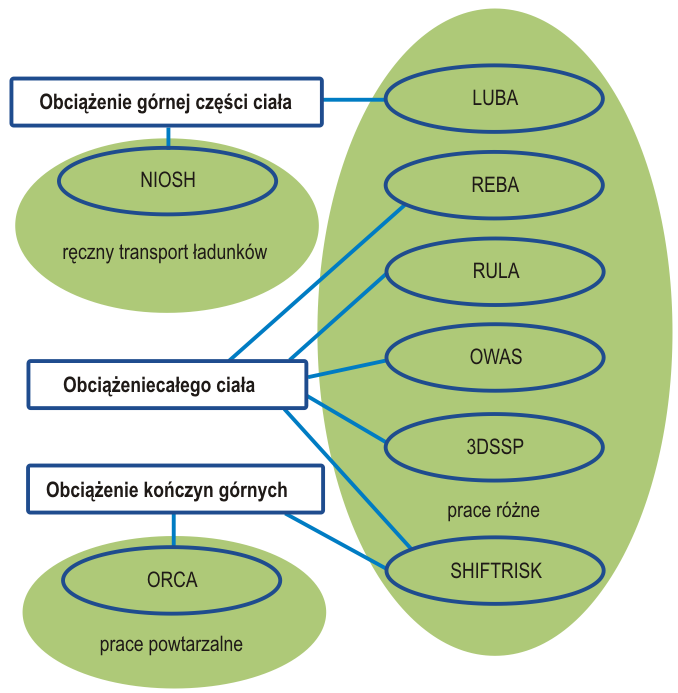Misją Instytutu jest dzialalność naukowo-badawcza prowadząca do nowych rozwiązań technicznych i organizacyjnych użytecznych w kształtowaniu warunków pracy zgodnych z zasadami bezpieczeństwa pracy i ergonomii oraz ustalanie podstaw naukowych do właściwego ukierunkowywania polityki społeczno-ekonomicznej państwa w tym zakresie.
PRINCIPLES OF ASSESMENT, METHODS OF CONTROLLING AND REDUCING THE MUSCULOSKELETAL LOAD
EVALUATION OF THE LOAD AND THE RISK OF DEVELOPMENT OF MUSCULOSKELETAL DISORDERS AS THE BASIS FOR PREVENTIVE ACTION
An important step in determining the optimal (i.e. causing the lowest negative impact on workers’ health) load on the musculoskeletal system during work is to quantify the variables associated with the performed work tasks and determining the musculoskeletal load.
Due to the fact that biomechanical factors have a decisive role in the development of MSDs, a reduction of the musculoskeletal load, and thus a reduction of the risk, is possible through the proper selection of the values of parameters affecting the load, i.e. parameters describing the biomechanical factors of the performed work tasks. When considering the worker’s musculoskeletal load under the influence of the work tasks performed, one can speak of the external load and internal load. The external load can be evaluated based on the parameters describing the work performed and is characteristic for the postureand the work process. The internal load is the response of the organism to external load, expressed by changes in physiological parameters, and also depends on individual factors describing the worker.
There are many methods to assess the musculoskeletal load resulting from work tasks. The methods used differ primarily in the manner of handling identification of the associated risks and evaluation of the load and, in certain cases, specifying the value of the associated risk. Only those methods that contain risk classification criteria may be used for risk evaluation. Methods of musculoskeletal load evaluation make it possible not only to conduct a risk assessment but also to prevent the development of MSDs in workers. These methods can be qualified differently and on the basis of different criteria.
INTERNAL LOAD ASSESSMENT METHODS
Physiological methods based on measurements of parameters, such as heart rate, blood pressure or measurement of the electromyographic signal recorded from selected muscles, shall be used as the method of assessing the internal load. This applies both to the tasks performed at different values of exerted forces and at different body postures during work.
Surface electromyography is a particularly useful tool for the assessment of the load and fatigue of the musculoskeletal system. The evaluation in this method is carried out on the basis of an electromyogram analysis (EMG), recorded from selected muscles involved in the work tasks. This method is particularly useful when measuring the signal from the muscles immediately below the skin and from the relatively large muscles, allowing easy positioning of the test electrodes (Fig. 1). It is assumed that the muscle effort is proportional to muscle tension, as demonstrated by the relationship between muscle strength and the value of the appropriately processed EMG signal amplitude generated by a particular muscle.

Fig. 1. Surface electrodes recording EMG signal from the muscles: trapezius muscle (1), deltoid muscle (2), extensor carpi ulnaris muscle (3)
The EMG signal is stochastic in nature and is contained in the frequency band of approximately 5 ¸ 1,000 Hz. However, it is assumed that the upper limit is 450 Hz (above 450 Hz, harmonics components are neglected). In addition to frequency, the parameter characterising the EMG signal is its amplitude, which is contained within the range of several μV at rest to several dozen mV during the maximum muscle tension.
The EMG signal is the source of much information on the processes taking place in the muscle, including muscle load and fatigue. However, the unprocessed EMG signal carries only the qualitative information, with the use of which it can be ascertained whether the muscle is active and whether it generates force. Figure 2 shows the course of the unprocessed EMG signal recorded within 1 minute. There is a clear increase in the amplitude of the signal resulting from the increase in muscle strength. On the basis of a record of the unprocessed EMG signal, only a qualitative assessment is possible indicating whether the muscle operates with a higher or lower force. For quantitative information, the signal must be mathematically processed. It can be used to distinguish parameters characterising the EMG signal, which indicate the processes taking place in the muscle.

Fig. 2. Course of the unprocessed EMG signal.
Muscle fatigue arises from the processes that change the muscle capabilities to maintain a specified level of force or static body posture,and is defined as a decrease in the ability to generate force as a result of increasing effort. Changes occurring under the influence of muscle fatigue are visible in the recording of the electromyogram by changing the values of parameters of the EMG signal. The process of muscle fatigue causes an increase of the EMG signal amplitude and a shift of the power spectrum towards low frequencies, as evidenced in the EMG signal parameter change. Muscle fatigue may be estimated using the following selected EMG signal parameters:
- Root mean square of the amplitude (RMS)
The EMG signal is stochastic with a mean value equal to zero. For this reason, RMS is considered the measure of EMG signal amplitude. Many researchers have noticed dependencies indicating the relationship between the EMG signal amplitude and muscle tension or intra-muscular pressure, both during isometric contractions and the contractions of any muscle during work. The relationship between the EMG signal amplitude and the force developed during muscle contractions may be linear or exponential, with a greater increase in the EMG signal amplitude than the force values. It was also demonstrated that muscle fatigue causes an increase in the EMG signal amplitude. - Median power frequency (MPF)
Muscle fatigue is demonstrated by moving the EMG signal power spectrum towards low frequencies. This offset is associated with a reduction of the conduction velocity of the activation wave in the muscles. - Zero crossing rate (ZC)
Recent years have shown that the number of times the EMG signal crosses the zero level in a time unit can be a measure of muscle fatigue. This figure decreases with the increase in fatigue in the muscle.
In conclusion, it can be concluded that electromyography using surface electrodes is a non-invasive method allowing to estimate muscle strength in certain sufficiently large muscles or groups of muscles situated directly below the skin. The popularity of this method is mainly because there is no other non-invasive method that would give more information on the muscle load and muscle fatigue. However, it is an indirect method which is very dependent on individual characteristics of the studied person and characterised by a high measurement uncertainty. The recorded signal is obtained not only from the muscle over which the electrode is stuck on the body skin, but also from the muscles surrounding it. The analysis of the EMG recorded signal, even using the computer, is very time-consuming.
EXTERNAL LOAD ASSESSMENT METHODS
The methods of assessment of the external load differ in the way in which the parameters describing the work performed are identified, as well as the way in which the load is being assessed and, in certain cases, the way in which the risk associated with this load is determined. The methods of assessing the external load may be grouped due to their different characteristics; the methods vary according to the body area to be evaluated, the type of work tasks covered by the method, the accuracy of the input data and the load assessment procedure (Fig. 3).

Fig. 3. Application of different methods to assess loads of specific body areas (upper limbs, upper body, whole body) and of the specific nature of the work (manual handling of loads, repetitive work, varied work) (Roman-Liu, 2015).
Some methods make it possible to evaluate the back, upper limbs and lower limbs independently, while other methods provide an overall assessment, and others only include, for example, the upper limbs or upper body. Some of the methods are dedicated to load assessment for only one specific type of task, such as manual transport of loads or repetitive work of the upper limbs.
The assessment of the load and the risk of development of the musculoskeletal disorders shall be carried out using the methods of assessment of the external load in the same stages:
a) recording, e.g. using a video recording of a worker during several work cycles,
b) selection of postures to be evaluated,
c) preparation of timing with the assignment of each task to its duration,
d) classification of postures in the joints in selected body postures,
e) for each of the tasks specified in the timing, assignment of input parameters defining body postures and the applied force of values, ranges of values or qualitative measures,
f) load assessment using a method-specific assessment procedure – and if the method also assesses the risk – the reference of the load factor value to the criteria allowing the risk to be classified in one of the evaluation zones.
The accuracy of the methodology is determined by all stages, which means that the accuracy of the assessment made depends both on the accuracy of the input data and on the calculation or estimation of the load in the adopted assessment system.
The input data refer to the body posture, the exerted force and the time sequence, through the values or ranges of measured parameter values. However, in some methods, the postureassessment is qualitative. Load assessment procedures are based on simple load estimation tables, simple mathematical dependencies up to complicated calculation procedures in which calculations are performed using computer programs.
The body postures to be assessed shall be selected in such a way as to take account primarily of the holding time or of the possible loading of the body posture. The selected body postures to be assessed may be those that occur for most of the working time, or those defined by the worker himself/herself as straining his/her musculoskeletal system.
RULA and REBA methods
NIOSH method
OCRA method
SHIFTRISK method
OWAS method
STRAIN INDEX (SI) method
INTEGRATED MODELS
The acceptable values or criteria delimiting the zones of risk of the development of musculoskeletal disorders may be determined using psychophysical methods; these are methods for measuring the physical capabilities of humans. These methods are based on the measurements of maximum potential of the tested persons or on the determination of how many percentages of the population being tested can be subjected to a specific load without prejudice to health. The tests may concern the maximum force exerted by specific muscle groups, the maximum weight of the lifted loads, or the maximum holding time of the specified load.
Integrated models allow the determination of a parameter value as a function of other parameters based on simple mathematical dependency. An example of an integrated model could be equally mathematical, showing the permissible number of repetitions as a function of the external force. Limits values for low, medium and high risk related to performing repetitive tasks are shown in Figure 1. Mathematical relationships allow to determine the admissible number of cycles during a working day (variable y) for a specific external load (variable x).

Fig. 1. Relationship between the number of cycles per work shift (Y axis) and the external force.


